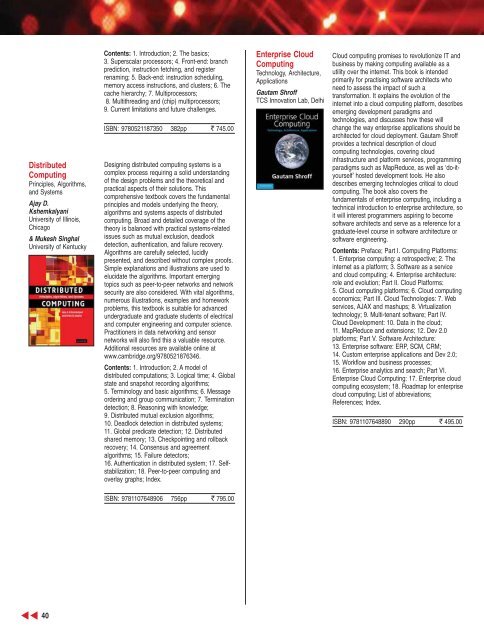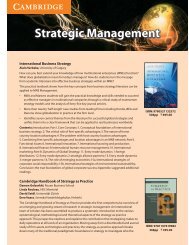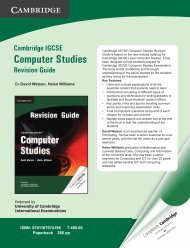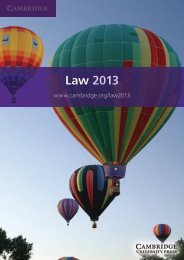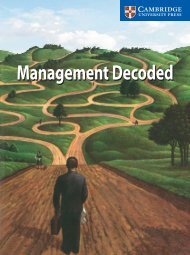ENGINEERING - Cambridge University Press India
ENGINEERING - Cambridge University Press India
ENGINEERING - Cambridge University Press India
You also want an ePaper? Increase the reach of your titles
YUMPU automatically turns print PDFs into web optimized ePapers that Google loves.
Distributed<br />
Computing<br />
Principles, Algorithms,<br />
and Systems<br />
Ajay D.<br />
Kshemkalyani<br />
<strong>University</strong> of Illinois,<br />
Chicago<br />
& Mukesh Singhal<br />
<strong>University</strong> of Kentucky<br />
Contents: 1. Introduction; 2. The basics;<br />
3. Superscalar processors; 4. Front-end: branch<br />
prediction, instruction fetching, and register<br />
renaming; 5. Back-end: instruction scheduling,<br />
memory access instructions, and clusters; 6. The<br />
cache hierarchy; 7. Multiprocessors;<br />
8. Multithreading and (chip) multiprocessors;<br />
9. Current limitations and future challenges.<br />
ISBN: 9780521187350 382pp ` 745.00<br />
Designing distributed computing systems is a<br />
complex process requiring a solid understanding<br />
of the design problems and the theoretical and<br />
practical aspects of their solutions. This<br />
comprehensive textbook covers the fundamental<br />
principles and models underlying the theory,<br />
algorithms and systems aspects of distributed<br />
computing. Broad and detailed coverage of the<br />
theory is balanced with practical systems-related<br />
issues such as mutual exclusion, deadlock<br />
detection, authentication, and failure recovery.<br />
Algorithms are carefully selected, lucidly<br />
presented, and described without complex proofs.<br />
Simple explanations and illustrations are used to<br />
elucidate the algorithms. Important emerging<br />
topics such as peer-to-peer networks and network<br />
security are also considered. With vital algorithms,<br />
numerous illustrations, examples and homework<br />
problems, this textbook is suitable for advanced<br />
undergraduate and graduate students of electrical<br />
and computer engineering and computer science.<br />
Practitioners in data networking and sensor<br />
networks will also find this a valuable resource.<br />
Additional resources are available online at<br />
www.cambridge.org/9780521876346.<br />
Contents: 1. Introduction; 2. A model of<br />
distributed computations; 3. Logical time; 4. Global<br />
state and snapshot recording algorithms;<br />
5. Terminology and basic algorithms; 6. Message<br />
ordering and group communication; 7. Termination<br />
detection; 8. Reasoning with knowledge;<br />
9. Distributed mutual exclusion algorithms;<br />
10. Deadlock detection in distributed systems;<br />
11. Global predicate detection; 12. Distributed<br />
shared memory; 13. Checkpointing and rollback<br />
recovery; 14. Consensus and agreement<br />
algorithms; 15. Failure detectors;<br />
16. Authentication in distributed system; 17. Selfstabilization;<br />
18. Peer-to-peer computing and<br />
overlay graphs; Index.<br />
Enterprise Cloud<br />
Computing<br />
Technology, Architecture,<br />
Applications<br />
Gautam Shroff<br />
TCS Innovation Lab, Delhi<br />
Cloud computing promises to revolutionize IT and<br />
business by making computing available as a<br />
utility over the internet. This book is intended<br />
primarily for practising software architects who<br />
need to assess the impact of such a<br />
transformation. It explains the evolution of the<br />
internet into a cloud computing platform, describes<br />
emerging development paradigms and<br />
technologies, and discusses how these will<br />
change the way enterprise applications should be<br />
architected for cloud deployment. Gautam Shroff<br />
provides a technical description of cloud<br />
computing technologies, covering cloud<br />
infrastructure and platform services, programming<br />
paradigms such as MapReduce, as well as ‘do-ityourself’<br />
hosted development tools. He also<br />
describes emerging technologies critical to cloud<br />
computing. The book also covers the<br />
fundamentals of enterprise computing, including a<br />
technical introduction to enterprise architecture, so<br />
it will interest programmers aspiring to become<br />
software architects and serve as a reference for a<br />
graduate-level course in software architecture or<br />
software engineering.<br />
Contents: Preface; Part I. Computing Platforms:<br />
1. Enterprise computing: a retrospective; 2. The<br />
internet as a platform; 3. Software as a service<br />
and cloud computing; 4. Enterprise architecture:<br />
role and evolution; Part II. Cloud Platforms:<br />
5. Cloud computing platforms; 6. Cloud computing<br />
economics; Part III. Cloud Technologies: 7. Web<br />
services, AJAX and mashups; 8. Virtualization<br />
technology; 9. Multi-tenant software; Part IV.<br />
Cloud Development: 10. Data in the cloud;<br />
11. MapReduce and extensions; 12. Dev 2.0<br />
platforms; Part V. Software Architecture:<br />
13. Enterprise software: ERP, SCM, CRM;<br />
14. Custom enterprise applications and Dev 2.0;<br />
15. Workflow and business processes;<br />
16. Enterprise analytics and search; Part VI.<br />
Enterprise Cloud Computing: 17. Enterprise cloud<br />
computing ecosystem; 18. Roadmap for enterprise<br />
cloud computing; List of abbreviations;<br />
References; Index.<br />
ISBN: 9781107648890 290pp ` 495.00<br />
ISBN: 9781107648906 756pp ` 795.00<br />
40


